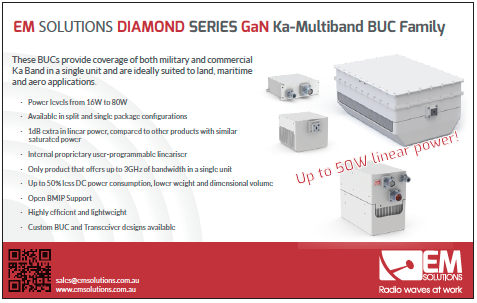You require multiple business models at hand to differentiate your services to address your main market challenges of today, while minimizing your OPEX at the same time.
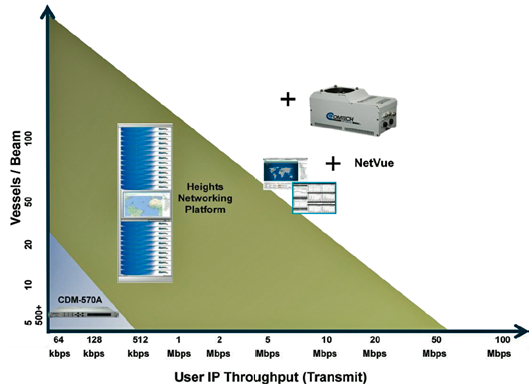
Figure 1. Comtech Product Positioning – Cruise, Cargo and Passenger Train
You have to lower the cost per Megabit over satellite as much as possible to create new revenue streams and give customers better value. At the same time, you need controlled, manageable and predictable capital expenses. One way to address this is by making the networking equipment as scalable as possible.
High Throughput Satellites (HTS) are going to put new demands on satellite networking platforms, throwing new issues that haven’t been at play before. One of the demands that will be placed on these satellite networking platforms is significantly higher packet processing performance. Networks will become increasingly complex as a result of HTS designs.
You need to be able to address those issues while providing benefits to your customers and your operations. In addition, many satellite networking customers have a global presence, and their global connectivity needs have to be addressed. They are likely to operate in more than one region of the world and they need to be able to have a platform that gives them connectivity where and when they need it and to be able to do so automatically and dynamically.
What are the main market challenges today for the Mobility sector of the industry? What is driving demand for services? How do you address these issues? Comtech EF Data offers the combination of the Heights Networking Platform, the LPOD-R Block up Converter (BUC), and the next generation CDM-570A IP Satellite Modem to meet the current and future market requirements for Mobility.
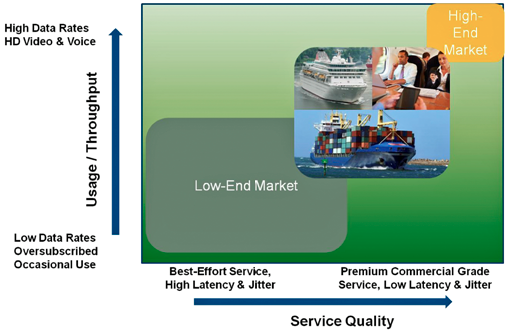
Figure 2: Heights Market Positioning
Comtech EF Data designed the Heights Networking Platform to focus not only on quality of service, but the larger scope of customers’ Quality of Experience (QoE). It is also a forward-looking design for your satellite network infrastructure to optimize your current capacity on FSS satellites, and has innovations for future networks based on High Throughput Satellites. That is a core requirement for any new network deployment today, and to preserve your investment to meet the challenges of tomorrow.
The LPOD-R offers unique performance features that most other manufacturers do not. Users of modems today may be exploring options for increasing uplink data capabilities. One straightforward method to achieve this goal is to increase the uplink power to support greater bandwidth and/or higher order modulation schemes. Historically, this has been difficult to achieve due to limitations in the available BUC power supply for both currently installed and newly procured modems. The high efficiency of Comtech EF Data’s LPOD-R BUC (PS.5 Model) overcomes this limitation.
In addition, it is imperative that ground manufacturers provide innovative, purpose-built and future-ready solutions that allow users to attain new levels of performance and economics to penetrate new markets and offer enhanced services. The CDM-570A/L & CDM-570A/L-IP are Comtech EF Data’s entry-level answer to this market challenge, providing the most efficient low data rate point-to-point solution while also powering the point-to-multipoint shared satellite networking market.
Unique Requirements for Mobility—Cruise, Cargo and Land Mobility
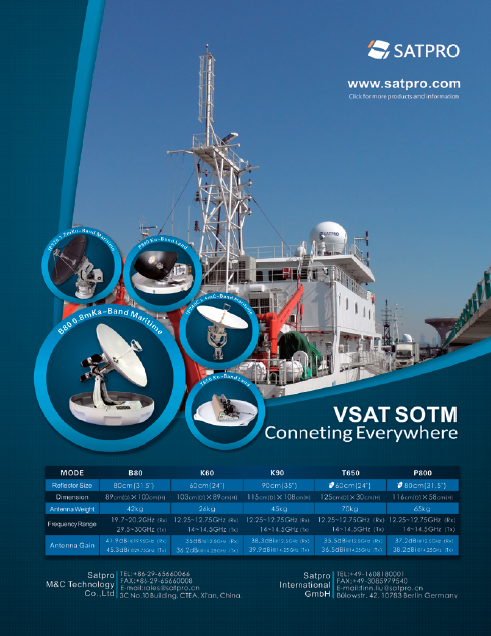 The connectivity requirements of the mobility segment of the industry are demanding, requiring immediate, reliable and cost-effective connectivity for crew, passenger and cargo connections landside. For cruise ships and passenger trains, the passenger communication and entertainment system is foremost in what is required of the satellite delivered networking system.
The connectivity requirements of the mobility segment of the industry are demanding, requiring immediate, reliable and cost-effective connectivity for crew, passenger and cargo connections landside. For cruise ships and passenger trains, the passenger communication and entertainment system is foremost in what is required of the satellite delivered networking system.
But in addition to that, for cruise and cargo ships this connectivity can make the ship an extension of their corporate network. For the ships’ crews this is having all or part of the services of an extended remote office on the ship. To this there are more issues that can be met with satellite connectivity, such as crew safety and security. This can be from crew training to the use of security cameras to anything that is sensed for security on the ship and carrying that back to headquarters for remote observation.
On cruise ships and certainly on container ships and other commercial vessels there is the issue of crew morale and welfare. The younger a crew member, the more likely he/she is to be dependent upon smartphones and other connected devices. They have theirs on the ship and they expect those to work as if they were ashore. In fact, there are some companies that understand this to the point where they deliberately provide those services onboard the ship. There are potential crew members who will not work on ships that are not connected.
There is also the requirement of providing Internet via satellite to a ship or train that range across a large geographic area. Roaming coverage over beams, satellites or teleports is needed, and need to be provided with little or no interruption of Internet access when changing beams, satellites, or teleports.
These are unique requirements to a mobile platform; it requires an antenna capable of maintaining lock on the satellite of interest while the platform is moving, it has an antenna control unit for communication with the remote gateway / modem, and the remote gateway or modem requires a mobility controller for local storage of satellite footprints and connection to GPS for location, and the intelligence to act on this information.
Because the ship or train is moving across satellite coverage beams, the satellite communications system needs to be able to perform beam switching within same transponder, or to a new beam on a different transponder on the same satellite, or to a new beam on a different satellite requiring antenna repointing, or to a new beam on a different satellite with a change of teleport requiring antenna repointing and teleport rerouting.
The change of beams without an antenna repointing should be done with the goal of no interruption of service. Mechanical antenna repointing and teleport traffic rerouting takes time and will have an interruption of service from a few seconds to a few minutes.
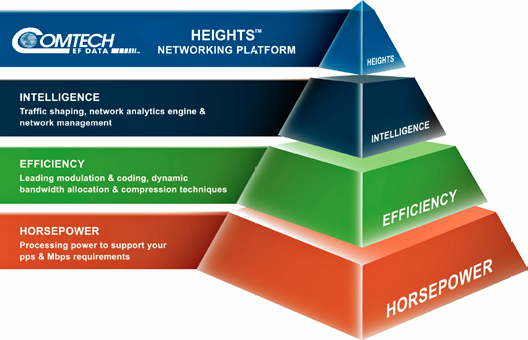
Figure 3. Heights Attributes
Also, a key requirement is the ability to have dynamic bandwidth allocation for the changes in bandwidth demand presented by the cruise ship or train. One example with a cruise ship; it may arrive at port at 8:00 or 9:00 a.m. in the morning and leave port at 5:00 p.m. the same day with shore excursions and mid-day activities on the ship. During the middle of the day, the demands on the network aren’t as great as they are when passengers start coming back aboard the ship. When they come back aboard the ship, they connect as the ship pulls out of port. These customers are on every type of social media, from Instagram to Facebook, etc., and this drives the peak bandwidth demand of the ship.
Applications Driving Demand For Cruise, Cargo and Passenger Trains
Cruise and Cargo Market
The IP-Enabled Bridge—This is the concept of the creation of the equivalent of a remote office on the bridge of a cruise or cargo ship. There is the provision of office applications on the bridge and elsewhere on the ship. In addition to these corporate applications, there may be other interactive applications such as video conferencing and voice, as well as Internet access. There are navigation systems and their applications and updates, weather information, and regulatory, such as port information, or digital homeland security forms.

Figure 4. Family of LPOD-R BUCs.
Vessel Management—Much of the ship or train management communications is vessel to headquarters with occasional ship-to-ship communications for cargo or cruise ships. This can be when there are incidents onboard the vessels, some sort of a mechanical problem or a problem that the crew is working. Hijacking could be tracked with that information via the GPS of the ship’s location, which could be constantly and automatically updated. What is gaining prominence are the remote monitoring and diagnostics on cruise and cargo ships, which are likely to find their way onto passenger trains. The Internet of Things has a foothold on cruise and cargo where there are growing numbers of machine-to-machine communications. For example, if there is cargo on a ship that is in a refrigerated container, that container has sensors, it is always under power and it is continually reporting its status to a server onboard the ship which can send back to headquarters, in real-time. This provides the assurance to headquarters and the customer that owns the cargo that it is at the proper temperature during its trip. It can also provide security information, such as has the door been opened on this cargo container during the cruise.
Passenger Expectation—This topic incorporates both entertainment and connectivity. There are connectivity requirements to be met for real-time, interactive applications that may be work related. It is hard to get away from work even on a cruise ship, and there are corporate applications that passengers may need to run. The satellite communications system has to be able to handle these applications. Some corporate applications are very sensitive to latency, and there are ERP applications that may need to be run by the passenger. Even if the application takes just 10 minutes, passengers need to know that they can get on their network, get their work done and then shut down their corporate applications. And, in the case where there are greater demands by the customer, such as Voice over IP, streaming video or even video conferencing, these applications also need to run smoothly with a high Quality of Experience.

Figure 5. CDM-570A Modem.
Crew Morale & Welfare—Onboard cruise and cargo ships this can be from basic Internet access to Skyping or social media access, and this is provided to keep the crew happy. On trains this may be only crew scheduling. There are cell sites onboard the cruise and cargo ships that the crew and passengers can use for business and personal use.
There is always the need for telemedicine application capability. Cargo ships may have 30 or 40 crew members where a cruise ship may have 4,000 to 6,000 passengers and crew. Telemedicine applications start with a medical kit that may be IP-enabled. It may be as simple as an EKG or blood pressure monitor that is in a portable medical kit with a crew member relaying information. Currently, that information is sent to not just the headquarters of the cargo, cruise, or train company, but also to telemedicine rated hospitals where they are connected to a doctor for their advice. The doctor is advised of the situation with the passenger or crew member and they make recommendations on what to do for the patient. This can include diverting to the nearest seaport or stopping at the next train station to disembark the patient. If the situation is dire and the ship is not close to shore, a helicopter may be dispatched to pick up the passenger or crew member.
Passenger Train Market
The passenger train market shares some of the same applications as the cruise & cargo market. However, the greatest of those are the passenger expectations for Internet quality of service, and secondarily that for maintenance and repair. These are the same as with cruise and cargo.
Comtech EF Data Product Positioning—Cruise, Cargo and Passenger Train
Where do we position our products in these sectors? Let’s look at this from the bandwidth demand against the number of mobile platforms (vessels or trains) or beams that you are trying to address (Error! Reference source not found.). We have a product that is a newer version of one of our workhorse modems, the CDM- 570A, and that can address smaller networks, i.e., a network with 20 vessels or less, within a few beams and low throughput requirement (under 1 Megabit) for each.
On the other hand, the Heights Networking Platform is ideally suited for larger networks (20+ mobile platforms) with higher throughput requirements. The largest fleet of cruise vessels in the world could be under a Heights network. Heights can be the fit to address these networks to deliver tremendous amounts of throughput to each ship in a 20+ vessel network, easily done at 50 Megabit for the return from the ship.
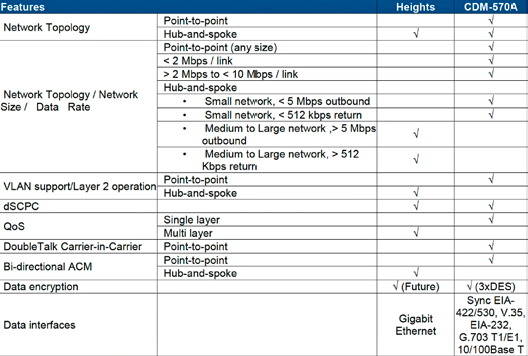
Table 1: Product Matrix
Currently, that profile of use would apply to a cruise ship, not to a cargo ship. Cargo ships fit well with their Machine to Machine (M2M), crew morale and IP-enabled bridge requirements with the CDM-570A, and perhaps with a low-end version of the Heights Networking Platform, with the H8 Remotes.
Supplemental to this and certainly enhancing the CDM-570A and Heights Networking Products are our RF products. Any of our RF products, in any band and any power levels can be managed by our NetVue Integrated Management System.
Facing Future Challenges
Comtech EF Data offers reliable, flexible and cost-effective solutions for your satellite-based network infrastructure. Our extensive range of networking platforms, RF products, satellite modems, bandwidth and network operations management systems are designed to solve the communication challenges between headquarters and your geographically dispersed ships and trains.
The New Solution
The Heights Networking Platform addresses the challenges in the market of the not so distant future (Figure 3, page 61). Looking at what the Heights platform can address from a very high level view the chart shows the user throughput on the vertical axis and the service quality on the horizontal axis.

In the lower left hand corner you find the low-end market of best-effort services. There is high latency and jitter with those best effort services and their reliability for anything more than consumer Internet access is questionable.
They are oversubscribed services with low data rates. As you go up towards the middle of the market, these are more commercial grade and premium commercial grade services where the latency and jitter requirements are very low; this is very important for enterprise applications.
There are higher data rates and throughput requirements with those kind of applications, which can include HD video and high quality voice. The premium, middle market is what the Heights platform has been designed to address.
Heights Key Differentiators
- • Comprehensive and dynamic bandwidth management
- • Bandwidth efficiency
- • Compression mechanisms
- • Highest link availability with bi- directional Adaptive Coding and Modulation (ACM)
- • Advanced multi-level Quality of Service (QoS)
- • True layer 2 operation
- • Low latency and jitter
- • High throughput and packets per second processing capacity
Designed to address the market challenges and meet the evolving demands of a diverse multi-tenant end user community, Heights is a scalable networking platform that utilizes a fully managed platform with seamless integration into a service provider’s network. The most net efficient, flexible and powerful platform in the industry, Heights leverages a single comprehensive user interface teamed with a powerful traffic analytics engine that allows customers to easily design, implement, monitor, control and optimize their network.
The result is an elevated QoE for users. Equipped to support the most demanding networks on traditional wide beams, new HTS spot beams or a combination of both, users can increase market share and grow revenues while controlling costs.
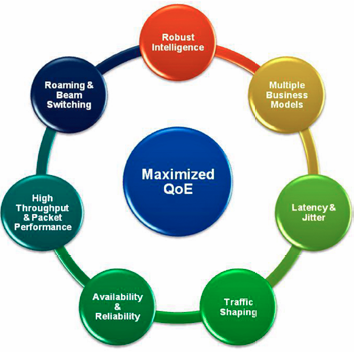
Figure 6: Approaches to Maximize QoE.
The Heights Networking Platform provides the best technology that is available from Comtech in one platform. You now get the benefit of having much greater horsepower on these devices than what you can get with any other competitive platform.
It is greatly more efficient than competitive platforms; the very expensive satellite capacity is used as sparingly as possible so that the most Megabits is extracted out of the satellite capacity per dollar than ever before.
And you need the intelligence to be able to not just monitor the entire network, but be able to perform analytics for trending and anomalies, designed for predictive and proactive network management to address issues before their potential impact. The intelligence, horsepower and efficiency of this platform provide unmatched performance while minimizing the Total Cost of Ownership (Figure 3).
RF Products
Our LPOD-R family of Outdoor Amplifiers / Block up Converters (BUCs) deliver rated power, guaranteed, to the transmit waveguide flange at the 1 dB compression point (Figure 4). There are three LPOD-R models available—PS .5, PS 1 and PS 1.5.
Each LPOD-R consists of a SSPA module with the Monitor/Control Processor (MCP), a power supply and a fan assembly. To ensure the maximum usable output power with stable operation over a wide range of environmental conditions, the units feature a low loss combining technique and MCP-based temperature-versus-gain compensation. The LPOD-R units are compact in size and weight and overcome the real estate constraints due to the limited size of the ships or trains.
The power demand of these devices is also some of the lowest power demand in the industry where they can fit into the requirements for a particular link that you would otherwise not be able to meet.
CDM-570AL Unit_72dpi.png CDM-570A – Point-to-Point or Point-to-Multipoint (Hub-and-Spoke) Modem
Comtech EF Data has been a thought leader in the high-end satellite ground equipment market for decades, providing users and service providers in the cruise and cargo industries with the most cost-effective satellite networking solutions.
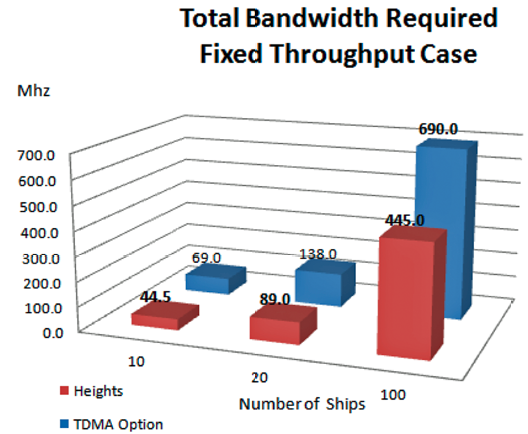
Figure 7: Comparison of Total Inbound and Outbound Bandwidth Required Between Heights and TDMA option with a Fixed Throughput (100 Mbps Outbound, 40 Mbps Inbound carriers).
The CDM-570A has industry-leading performance and flexibility in a 1 RU package at a very competitive price. With support for VersaFEC® low latency LDPC Forward Error Correction (FEC), the revolutionary DoubleTalk® Carrier-in-Carrier® bandwidth compression, and optimized transmit filter rolloffs, the CDM-570A provides significant bandwidth savings.
This entry-level modem is perfectly positioned to provide the most efficient solution to best support low data rate point-to-point links, while also powering the point-to-multipoint shared satellite networking market for small to medium networks.
Networking Platform & Modems Suitability For Mobility
The CDM-570A and the Heights Networking Platform can address these mobility markets. Table 1 summarizes the best fit for these products.
Focus On Quality Of Experience
You want to deliver the best QoE to your customers and you need a set of solid approaches to do that (Figure 6, next page). Providing service with a high QoE requires optimization of a number of network settings and features. Addressing all of these can insure customer retention and lower churn.
Robust Intelligence
Managing large-scale and geographically distributed networks are extremely difficult. Service providers must be able to have the smartest monitor and control system available to help you make decisions within your network. One of the primary issues is not the acquisition of data, but it is the ability to analyze and synthesize actionable information from that data.
Comtech EF Data’s solution to these issues is our NetVue™ Integrated Management System with dynamic bandwidth management. It provides the benefits of network capacity utilization views and availability that is significantly enhanced over what is currently available on any other platform. You can have one seat to manage this entire network.
And, with this, you don’t want to just monitor your digital transmission equipment; you want to be able to monitor the RF that’s connected to it. Trending analysis of the performance of the RF, for example, the temperature and the consumed power of that RF compared with the trending on the status of the digital equipment it is connected to can provide a predictive insight.
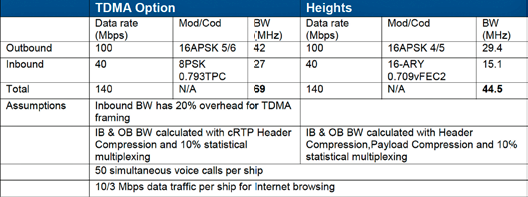
Table 2: Comparison of Total Inbound and Outbound Bandwidth Required Between Heights and TDMA option with a Fixed Throughput, 10-Ship Example
This may be repeatable on a periodic basis or there may be some aberration that is occurring. That kind of intelligent information will guide your decisions about that particular site or product and whether or not maintenance should be scheduled.
NetVue leverages a single intuitive graphical user interface teamed with a powerful traffic analytics engine that acts as a user-friendly front-end to monitor and control network equipment and allows simplified design, implementation, monitor, control and network optimization for an elevated QoE. It is comprehensive network management that allows users to intelligently maximize resources, ensure network uptime and provides the elevated levels of service that are required to support fixed and remote sites.
NetVue is coupled with a dynamic bandwidth manager to provide scalable, dynamic satellite capacity management that facilitates bandwidth-sharing, automates space segment allocation and manages “pools” of available bandwidth. This feature blends the flexibility of MF-TDMA with the efficiency of SCPC by providing the architecture to dynamically manage bandwidth operations without requiring dedicated bandwidth for each remote location.
Customers can remotely modify bandwidth allocations as requirements change automatically by the type of traffic or the traffic load, or manually, without requiring costly upgrades or site visits. Unlike MF- TDMA systems, return traffic packets are not fragmented to meet the burst length criteria, which in those systems impose additional overhead management traffic.
Using NetVue for network provisioning, monitoring and control reduces NOC personnel workloads and data duplication through operations optimization and automation. It also reduces CAPEX and Total cost of Ownership (TCO) through increased efficiency of network usage and improves QoE through error minimization, proactive troubleshooting and trouble ticket prioritization.
Support Of Multiple Business Models
How can service providers support multiple business models in a cost-effective manner and create service differentiation? Our solution resides in the Heights Networking Platform.
Heights is a robust carrier-class solution that supports multiple business models simultaneously, from full hub ownership, to collocation at a third party teleport facility to Virtual Network Operator (VNO) operations. The Heights platform comes with two hub configurations each seamlessly enabling connectivity with existing IP infrastructure and capable of providing user IP throughputs of up to 450 Mbps per outbound.
Heights Solo—Designed to support a single private network with one shared outbound and shared bandwidth pool for inbound connections.
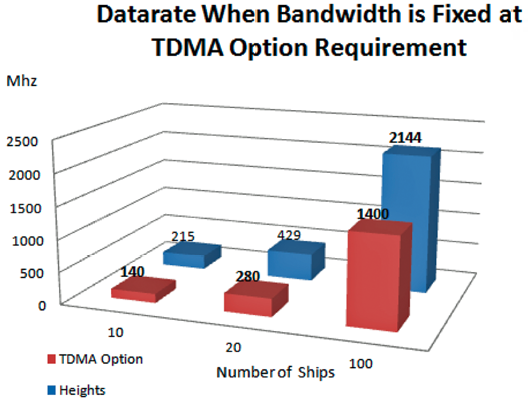
Figure 9: Comparison of Total Inbound and Outbound Throughput Provided Between Heights and TDMA Option with a Fixed Bandwidth of 69 MHz (42 MHz for the Outbound, 27 MHz for the Inbound)
Heights VNO—Designed to support the hosting of multiple VNO networks simultaneously, it provides multiple outbound carriers along with multiple bandwidth pools for inbound connections. The VNO capability is implemented with Heights to support multiple service providers over the same platform and create virtual customer networks based on secured access policies defined by the Host Network Operator (HNO). Three VNO models are supported.
Model 1: Each VNO has separate hardware and a separate outbound/inbound bandwidth pool.
• VNOs only share the NetVue NMS with bandwidth manager and the rack This model can meet the needs of a customer who wants to operate his own dedicated network in the service providers teleport using the service providers RF and antenna(s)
Model 2: The VNOs share the outbound bandwidth but have a separate inbound bandwidth pool.
• In addition to sharing the NetVue NMS with bandwidth manager and the rack, the VNOs also share the hub modulator, traffic optimizer and hub multi-channel receiver
• The outbound bandwidth is shared among VNOs using multi-tier QoS bandwidth management
• Customers of a VNO share their VNO’s dedicated inbound bandwidth pool
Model 3: The VNOs share outbound and inbound bandwidth pools.
• All the hub equipment is shared
• The outbound bandwidth is shared among VNOs using multi-tier QoS bandwidth management
• The Inbound bandwidth pools are shared among VNOs
The ultimate benefit for you is to tie your costs to revenues via a gradual network expansion, quickly adapting to changing business requirements and having the ability to manage the network components as part of a complex network management system. At the same time, providing full end-to-end class-based monitoring will create opportunities for automation, user satisfaction, and additional business revenue opportunities. The scalability and flexibility of Heights removes the traditional barriers to entry in the satellite market.
Minimize Latency & Jitter
Citrix and similar business applications are sensitive to latency. Timeouts cause unnecessary retransmissions further straining the satellite network or even terminating connections. This leads to unsatisfactory user experience, decreased productivity and potentially negative impacts to your bottom line.
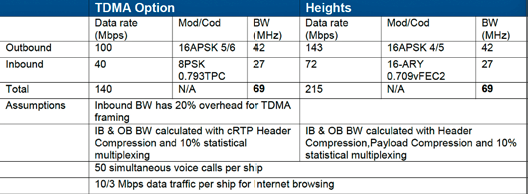
Table 3: Comparison of Total Inbound and Outbound Throughput Provided Between Heights and TDMA Option with a Fixed Bandwidth of 69 MHz, 10-Ship Example.
Real-time applications such as VoIP and videoconferencing require minimal jitter. If packets are not received with near-constant time variation, tight jitter thresholds are surpassed for many business applications, causing connections to terminate. On the same token a variable packet reception reduces perceived voice and two- way video quality thus lowering the Quality of Experience (QoE).
The way we tackle this issue is by combining our multi-level group QoS with our technology efficiencies while providing the levels of horsepower in the remote equipment required for faster packet processing. With Adaptive Coding and Modulation (ACM), group QoS is an important feature to improve bandwidth management while meeting and maintaining desired SLAs. It enables service providers to seamlessly share the outbound and inbound among multiple customers for differentiated services with a focus on QoE.
Another powerful feature is our next generation, inbound VersaFEC-2 high-performance LDPC Forward Error Correction waveform with short-block, suitable for applications requiring minimal latency and jitter. VersaFEC-2 short block was designed for low to medium throughput. It is one of the two operational modes and provides 36 MODCODs (BPSK to 32-ARY) with better performance than the industry-proven VersaFEC at similar or better data latencies. VersaFEC-2 High Rate, designed for higher throughput provides 38 MODCODs (BPSK to 32- ARY) with coding gain and spectral efficiencies better than DVB-S2 and on par with DVB-S2x at approximately 1/8 the data latency of these two standards.
Coupled with Group QoS and VersaFEC-2 are the Heights Remote Gateways. These powerful tiered Remote Gateways are designed to meet the specific needs of the mobility end users with inbound user IP throughput of up to 64 Mbps and packet processing with 50,000 packets per second (pps) currently and up to 140,000 pps in the future with all optimization features, such as compression, enabled.
With these performance levels, the Heights Remote Gateways have the most powerful IP packet processing engines in the market. They provide the best support for high throughput and simultaneous high definition drilling video sessions working in tandem with high data rate mission-critical business applications, Internet access and voice connections.
With Group QoS, VersaFEC-2 short block and our powerful remote equipment, you will ensure your end users’ most latency and jitter sensitive applications operate properly to maximize productivity and ensure the lowest overhead with highest bits/Hz ratios.
Traffic Shaping
In this industry, to maximize user experience, it is critical to segregate bandwidth by real-time applications versus non real-time applications across shared satellite bandwidth or prioritize critical monitoring functions to take precedence over non critical applications such as email. The challenge here is to ensure priority for real- time applications (VoIP, video conference) services with a predefined SLA.
Our multi-level QoS feature sets Comtech EF Data apart and leverages a powerful classification and traffic shaping engine that ensures the highest “value” traffic is prioritized, the most important services are uninterrupted and business applications continue to function properly.
A key feature for traffic shaping is compression. Our header compression technique looks inside the IP headers and examines the data flow to determine what we can remove as unimportant data before we send that information over the satellite, and then intelligently reinsert that data on the receiving end. In addition, there is a lot of redundancy in data streams, some of which can be removed before transmission over the satellite.
If a stream of data has been transmitted in the past, a much smaller representative set of data is sent along with a lookup location of past bit streams. By removing this unnecessary data, users can realize additional savings, increasing net efficiency even further. With lossless compression, Comtech EF Data ensures the complete accuracy of each bit on the remote end of the link, a key consideration for your end user’s mission critical applications. This type of accuracy requires significant horsepower on board the platform to be able to process this data at tens or hundreds of Mbps, which is what our Remote Gateways provide.
The result by leveraging these intelligent compression techniques is the conversion of a given number of “router bits” (those packets delivered to our units) into the least “satellite bits” (those transmitted through the spacecraft). Our equipment does all of this while providing the proper application-based and protocol- dependent Quality of Service throughout the network.
Availability And Reliability
The Mobility industry demands efficient and reliable connectivity available on a 24/7 basis, even during the most adverse weather conditions. As terrestrial infrastructure is not possible in the operating environments where these companies operate, end users are increasingly depending on satellite communications that can support the required throughputs. These are concerns that we, at Comtech EF Data are addressing with Heights, our networking platform.
Bi-directional ACM embedded in Heights provides a unique and important feature to provide high availability and reliability. With the ability to maximize throughput under all conditions – rain fade, inclined orbit satellite operation, interference and other impairments – bi-directional ACM allows for automatic change in modulation and coding (MODCOD) in response to link conditions in both directions.
Each remote can achieve maximum throughput thereby maximizing network efficiency and availability. An average throughput gain of 100% (or more) can be realized, when compared to using traditional rain fade margins. Integrated in Heights with advanced QoS and other optimization technologies, bi-directional ACM maximizes network efficiency and availability to maintain desired service levels.
Higher Throughput And Packet Performance
In exploration and production environments large amounts of data are collected that must be transmitted to a central data processing site for assessment. Huge files need to arrive quickly, error free, and with no lost packets or truncation.
Our remote equipment meets the unique, vertical-specific needs of end users. Each remote in the network is assigned bandwidth on-demand from a shared bandwidth pool by the dynamic bandwidth management engine (dSCPC) and leverages its own optimal modulation and coding method. The dynamic bandwidth allocation is ideal for these bulk file transfers since bandwidth is dynamically assigned where needed. Our Remote Gateway’s processors are capable of supporting high packets per second (pps), from 35,000 pps up to 140,000 pps with all multi-layer optimization features enabled, thus overcoming the packet processing limitation found in other competitive products on the market.
These performance levels enable the Heights Remote Gateway suite to support the most demanding of traffic mixes in a single unit and provide the headroom required to grow your business. We leverage an extensive combination of modulation and coding for maximum efficiencies to provide the ability to transmit the high throughput that your end users demand.
Roaming And Beam Switching
For roaming vessels, global connectivity and seamless coverage are main concerns as customers demand the same user experience as any fixed networks without the geographic constraints. Providing global coverage requires a seamless operation of several beams, different satellite footprints, multiple hubs and teleports.
The way we are addressing these concerns is with our Global IP roaming implementation. The Heights networking platform uses a mobility controller embedded in the Remote Gateway on board-vessels. This onboard mobility controller interfaces to the Antenna Control Unit (ACU) and maintains satellite footprint maps, initiates beam switching and handoff as the Remote Gateway moves through satellite footprints. It offers a common management interface for the mobility server and the ACU by providing a set of commands, information, interfaces and status queries.
In networks using a TDMA option platform the mobile location information is stored at the hub. Issues with hub- based information arise during times when communications may be lost between the hub and the remote. In these cases, no location or switching information is received from the hub and the remote may disengage from the network.
With our Global IP roaming implementation, the remote does not need to be connected to the hub to handover from one satellite to another. Because the intelligence is on-board the vessels, the handover decisions and parameters are intelligently performed on-board, thus minimizing automatic beam switching times and guaranteeing that connectivity is dynamically maintained on the move.
The transition from one beam to another can be from satellite to satellite. There may be a beam switch from one beam to another where the “new” beam is going to a different teleport. All of that needs to be performed in a way that has a minimal impact on the stream of traffic with the ideal being a switch that causes no interruption to maintain a high QoE.
Heights For HTS
The operational environment of High Throughput Satellites carries unique issues for the ground equipment namely, its scalability, a multiple outbound transmit capability and the digital power of the ground equipment. The private network Solo and the VNO hub of the Heights platform are flexible and scalable to support any satellite architecture in any frequency band. The Heights VNO hub provides a lower cost approach to enter service.
The Heights Networking Platform has a multiple outbound transmit capability that is very unique. This design of a single modulator to be able to transmit smaller, multiple outbound carriers fits the spot beam requirements of High Throughput Satellites. On the receive side of the hub, there is sharing of the demodulator banks for a lower hub CAPEX solution.
The digital power of the ground equipment provides an extensive number of modulation and coding combinations to maximize the efficiency across the satellite links. There is also the high processing power on the remote gateways to insure increased throughput. Together these capabilities are such that Heights enables the promise of the High Throughput Satellites to deliver greater throughput to any given location for the same antenna size and the same BUC size than with existing satellites.
Use Case—More User IP Throughput With Heights
In the following use case, we look at an example of 10, 20, and 100-ship network and compare Comtech EF Data’s Heights performance against that of a TDMA option.
We will examine this case from two perspectives; one where we fix the throughput for both the TDMA option and ourselves and we determine the satellite bandwidth required to support it. The other, inverse case is where we fix the bandwidth to that required by the TDMA option to support a 100 Mbps Outbound carrier, 40 Mbps Inbound carrier total requirement and then determine what additional throughput can be expected from the Comtech solution.
For the fixed throughput perspective, (Figure 8), for a 10 ship network, with a 100 Mbps Outbound carrier and a 40 Mbps Inbound carrier, Heights requires a total of 44.5 MHz of satellite capacity (29.4 MHz for the Outbound, 15.1 MHz for the Inbound carrier), while the TDMA option requires a total of 69.0 MHz (42MHz for the Outbound, 27 MHz for the Inbound) (Table 2). It is similar although more pronounced results in the twenty ship and a one hundred ship cases.
In the fixed bandwidth case, (Figure 9), the bandwidth and throughput is the same as in Table 2 above for the TDMA option, in the 10 ship case with a total of 69 MHz (42 MHz for the Outbound, 27 MHz for the Inbound). Here, the Comtech case uses this same bandwidth but delivers more throughput. In this case, the Comtech Heights product can provide 143 Mbps for the Outbound (vs. 100 Mbps for the TDMA option), and 72 Mbps for the Inbound (vs. 40 Mbps for the TDMA option), a total of 215 Mbps in the same capacity where the TDMA platform can only provide 140 Mbps (Table 3).
This optimization of user IP throughput is mainly achieved due to the combination of our advanced technologies embedded in Heights such as outbound efficiency boost (EB), 5 percent optimized roll off factor, VersaFEC-2, IP encapsulation, lossless payload and header compression which increase the IP spectral efficiency.
The increased performance levels of Heights directly affect your bottom line and provide you with the opportunity to grow your business through a differentiated level of service. This is due to the fact that either:
• The additional user IP throughput (Mbps) will result in an increase in revenue stream with a given OPEX cost structure, or
• Less satellite resource (MHz) would be required for a given throughput (Mbps), resulting in a decrease in OPEX cost structure for a given revenue stream
Achieving Your Goals
To achieve your business growth goals, you need a powerful, dynamic networking platform that outperforms the rest and guarantees optimal levels of service beyond a one- or two-year business case.
Comtech EF Data’s extensive range of satellite networking platforms, satellite modems, RF products and dynamic bandwidth management tools will provide you with the solution to address the market demands of Mobility. Our newest product, the Heights Networking Platform, is future-proof, flexible, scalable and HTS- ready with minimal site intervention. It is designed to provide a higher QoE per user, at a lower cost per delivered bit, letting you increase your market penetration, expand your addressable markets, operate with better margins and minimize end-customer churn.
Heights is a fully managed platform with the intelligence to enable dynamic allocation of bandwidth when and where it is needed, with efficiency and horsepower to maximize QoE, all while minimizing the Total Cost of Ownership (TCO), and meeting stringent SLAs and tighter regulations.
comtechefdata.com

Frederick Morris is Vice President of Product Marketing for Comtech EF Data. In this role, he is responsible for the positioning and promotion of Comtech EF Data’s products. Previously at Comtech, he was Vice President of Global Sales Engineering, and was General Manager of Comtech EF Data Vipersat Network Products Group.
During his career, Morris has held various senior business development and technical marketing positions. Prior to joining Comtech EF Data, he was vice president of product management and development at Intelsat. Previous to Intelsat, he held the position of vice president of product management and sales support engineering at Verestar.
His extensive experience also includes senior level positions in product management and business development at SES Americom, Viacast Networks, and Hughes Network Systems. Morris holds a BSEE degree from the University of Connecticut and a MS in Technology Management from the University
of Maryland.


